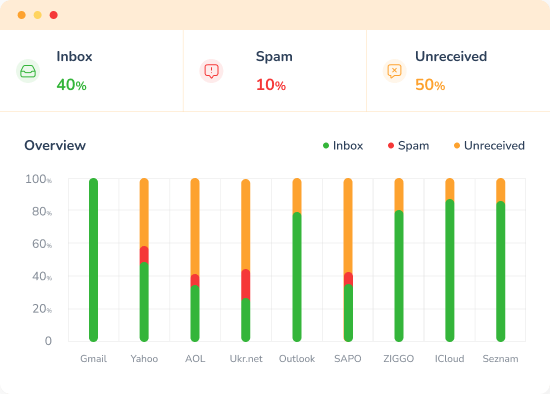Navigating the intricate landscape of email deliverability has become an essential skill for businesses and individuals alike. In an era where digital communication reigns supreme, ensuring that your emails reach their intended recipients has a profound impact on engagement, communication, and even the bottom line.
In this era of rapid technological advancement, achieving and maintaining a high inbox placement rate requires a deep understanding of the tools and strategies that can propel your emails past the myriad of obstacles standing between your message and its final destination.
In this article, we will delve into the realm of mastering inbox placement, uncovering the invaluable tools and tests that can significantly enhance your email deliverability success.
Join us as we explore the ever-evolving world of email communication, where insights and techniques pave the way for triumphant deliverability rates.
Understanding the significance of inbox placement
The significance of inbox placement extends beyond mere deliverability statistics. It embodies the difference between an email being relegated to the obscure confines of a spam folder, left unopened and overlooked, versus capturing the recipient’s attention and driving meaningful interactions. Achieving high inbox placement rates not only boosts the chances of your messages being seen promptly but also sets the stage for optimal engagement.
How inbox placement affects email marketing effectiveness
In the context of email marketing, where messages serve as conduits for brand messaging, promotions, and crucial communications, the impact of inbox placement becomes paramount. Emails that successfully make their way to the primary inbox are more likely to generate higher open rates, click-through rates, and conversions. This, in turn, can directly influence the overall success of your email marketing campaigns and contribute to building a positive rapport with your audience.
Factors influencing inbox placement rates
1. Sender Reputation and Authentication.
Your sender reputation plays a pivotal role in email placement. Internet service providers (ISPs) and email clients closely scrutinize the reputation of the sending domain and IP address. A history of sending relevant, wanted emails without triggering spam complaints or bounce-backs enhances your credibility and paves the way for better inbox placement. Additionally, implementing proper authentication protocols like SPF, DKIM, and DMARC adds an extra layer of trust to your messages.
2. Content Quality and Engagement.
The content of your email is not only scrutinized for relevance but also for its potential engagement. Modern algorithms assess the subject line, body text, images, and links to gauge user interest. If your content resonates with subscribers and aligns with their preferences, your emails are more likely to land in the inbox. Conversely, generic or overly promotional content may raise red flags and affect placement.
3. Subscriber Behavior and Interaction.
How recipients interact with your emails—whether they open, click, reply, or mark as spam—shapes the trajectory of your inbox placement. ISPs interpret these interactions as signals of email value and sender legitimacy. High engagement rates signal relevance and trustworthiness, boosting the likelihood of future emails making it to the inbox.
Inbox placement tests
The role of inbox placement tests has emerged as a fundamental strategy for ensuring successful deliverability. These tests serve as a critical tool in the arsenal of email marketers, offering insights into the intricate mechanics that determine whether your messages will achieve their intended destination.
Exploring the Purpose and Benefits of Inbox Placement Tests
At their core, inbox placement tests are designed to mimic the journey an email takes through various filters, algorithms, and spam detection mechanisms before it reaches the recipient. By subjecting your emails to these tests, you gain a firsthand understanding of how different ISPs and email clients perceive your content and sender reputation.
This knowledge empowers you to make informed adjustments to your email strategy, ensuring that your messages have the best possible chance of landing in the primary inbox.
The benefits of inbox placement tests extend far beyond the mere placement of your emails. They offer invaluable insights into the effectiveness of your content, the impact of your sender reputation, and the overall health of your email marketing efforts.
By identifying potential deliverability roadblocks and addressing them proactively, you can enhance engagement rates, optimize campaign performance, and foster stronger connections with your audience.
Inbox placement test review by Warmy.io

Warmy offers a free Inbox placement test that allows users to check where their messages are landing across various email providers.
Here’s a brief overview of how the test works:
1. Copy Email Addresses
Users need to copy a list of email addresses provided by Warmy. They can specify the type of separation required, with most email clients supporting a comma separation.
2. Paste the Email Addresses
Users should paste these email addresses into the “To:” section of their email client, type in any message, and then send it.
3. Check Email Deliverability
After sending the email, users can click on the “Check Email Deliverability” button on Warmy’s platform to see the results.
The results provide a wealth of information, including:
– Email deliverability rates with different providers.
– Whether the user’s domain is blacklisted.
– Information about the user’s DNS records.
Understanding ISP filtering and its impact
Internet Service Providers (ISPs) play a crucial role in the email ecosystem. They are responsible for delivering emails from senders to recipients, and in doing so, they employ various filtering mechanisms to ensure that their users are protected from unwanted or malicious content. Let’s delve into the intricacies of ISP filtering and its implications:
✅ Spam Filters
One of the primary tools in an ISP’s arsenal, spam filters scan incoming emails for characteristics commonly found in spam. This includes certain keywords, the reputation of the sending domain, and the structure of the email itself.
✅ Domain and IP Reputation
ISPs maintain databases that track the reputation of sending domains and IP addresses. If a sender has a history of sending spam or malicious content, their emails are more likely to be filtered out.
✅ User Feedback
ISPs take into account feedback from their users. If a significant number of users mark emails from a particular sender as spam, future emails from that sender are more likely to be filtered.
✅ Authentication Protocols
ISPs check for authentication protocols like SPF, DKIM, and DMARC. These protocols verify the sender’s identity and ensure that the email hasn’t been tampered with during transit.
✅ Content Analysis
ISPs analyze the content of emails for malicious links, attachments, or patterns typical of phishing attempts.
Addressing common inbox placement challenges
1. Dealing with Spam Triggers and Content Filters:
◾ Understand Common Triggers. Familiarize yourself with common spam triggers, such as certain keywords, excessive use of capital letters, or multiple exclamation marks. Avoiding these can reduce the chances of your email being flagged.
◾ Use Plain Text and HTML. Sending emails in both plain text and HTML formats can improve deliverability. Some spam filters may flag emails that only contain HTML.
◾ Avoid Large Attachments. Large or uncommon file types can trigger spam filters. If you need to share a large file, consider using a link to a cloud storage platform instead.
◾ Limit External Links. Too many external links, especially to untrusted or new domains, can be a red flag. Ensure that any links you include are relevant and point to reputable websites.
◾ Test Your Emails. Before sending out a campaign, use tools that test your email against common spam filters. This can provide insights into potential issues and allow you to make adjustments.
2. Reducing Spam Complaints and Unsubscribes:
◾ Segment Your List. Not every email is relevant to every subscriber. Segment your email list based on user behavior, preferences, or demographics to ensure that recipients receive content that is relevant to them.
◾ Provide Value. Ensure that your emails offer value to the recipient, whether it’s informative content, special offers, or updates. Emails that are perceived as valuable are less likely to be marked as spam.
◾ Easy Unsubscribe Process. Make it easy for recipients to unsubscribe from your emails. A clear and straightforward unsubscribe link reduces the chances of a recipient marking your email as spam.
◾ Honor Opt-Out Requests Promptly. If a user chooses to unsubscribe, ensure that their request is honored promptly. Continuing to send emails after a user has opted out can lead to increased spam complaints.
◾ Ask for Feedback. If a user chooses to unsubscribe, consider asking for feedback. Understanding why they chose to opt-out can provide valuable insights and help you improve future campaigns.
◾ Maintain a Consistent Sending Schedule. Sending emails sporadically or too frequently can lead to increased unsubscribes. Maintain a consistent schedule that your subscribers can expect.
Addressing inbox placement challenges requires a combination of understanding spam triggers, crafting high-quality content, and respecting the preferences of your subscribers. By focusing on these areas, you can improve deliverability rates and ensure that your emails reach their intended audience.
Reputation repair with email deliverability service: Warmy.io
Boost your email deliverability and ensure your messages reach their intended recipients with Warmy.io. This platform not only enhances your sender reputation but also provides automated mailbox warming, comprehensive monitoring, and seamless integration with popular email platforms. Don’t let your valuable emails land in the spam folder. Choose Warmy.io to elevate your email campaigns and achieve better engagement. Take action now and elevate your email game with Warmy.io!
Conclusion
Mastering inbox placement is more than just a technical endeavor; it’s an art that combines understanding your audience, crafting compelling content, and leveraging the right tools and tests to ensure your emails reach their intended destination.
Successful email deliverability is the cornerstone of effective digital communication, and as we’ve explored in this blog post, there are myriad tools and tests available to help you achieve this. By prioritizing inbox placement and continuously refining your approach based on feedback and analytics, you can ensure that your messages not only land in the inbox but also resonate with your audience.
Remember, in the vast world of email marketing, it’s not just about sending messages—it’s about making sure they’re seen, read, and acted upon. Embrace the tools and strategies discussed here, and you’ll be well on your way to email marketing success.











